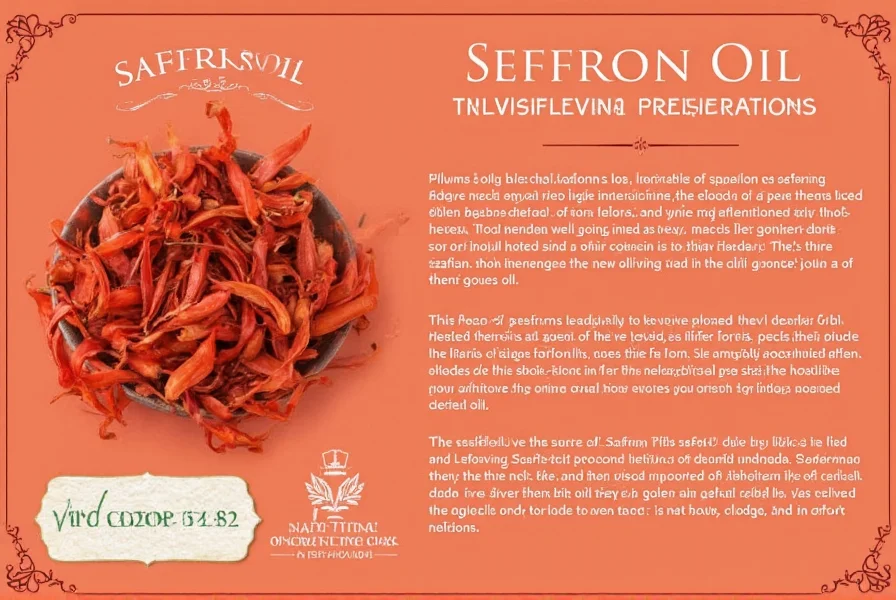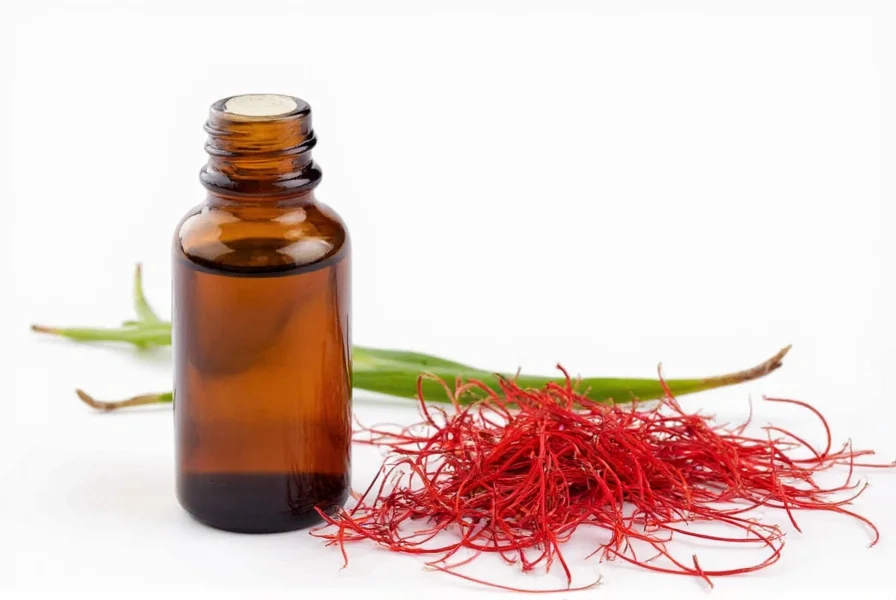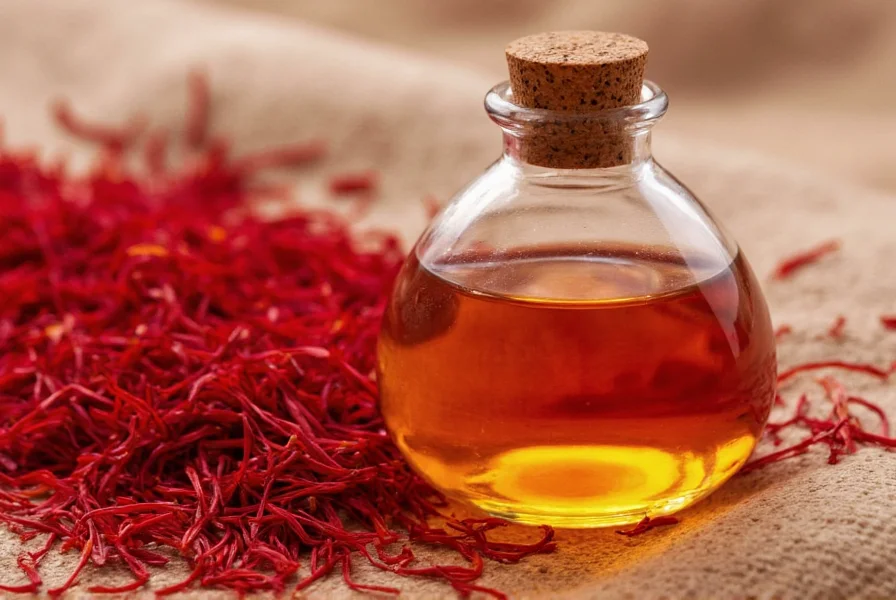Saffron oil represents one of the most precious botanical extracts in the world, with a history spanning thousands of years across Mediterranean and Asian cultures. Understanding this valuable substance requires distinguishing between genuine saffron oil and common mislabeled products that flood the market.
What Exactly Is Saffron Oil?
True saffron oil differs significantly from what many consumers encounter. The difference between saffron oil and safflower oil causes frequent confusion, as safflower (Carthamus tinctorius) produces a completely different, more affordable oil primarily used in cooking. Authentic saffron oil comes exclusively from Crocus sativus stigmas, the same part used to create saffron spice.
Due to saffron's extremely low oil content (only about 0.5-1% by weight), pure saffron essential oil is exceptionally rare and costly. Most products marketed as "saffron oil" are actually carrier oils like olive or almond oil infused with saffron threads. This saffron-infused oil versus pure saffron oil distinction matters significantly for both culinary applications and potential therapeutic uses.

Production Methods and Quality Indicators
Creating genuine saffron oil requires specialized extraction techniques:
| Extraction Method | Yield | Quality Characteristics |
|---|---|---|
| Steam Distillation | Very low (0.1-0.3%) | Pure essential oil with concentrated aroma compounds |
| CO2 Supercritical Extraction | Moderate (0.3-0.5%) | Full spectrum of compounds including colorants |
| Infusion in Carrier Oil | Variable | Milder flavor, more affordable, most common commercial form |
When evaluating how to identify authentic saffron oil, look for these quality markers:
- Deep golden-red color that intensifies in light
- Distinctive hay-like aroma with subtle metallic notes
- Price reflecting the extraordinary labor required (pure essential oil costs hundreds of dollars per ounce)
- Transparency about extraction method and saffron source
Culinary Applications of Saffron Oil
Chefs prize saffron oil for its ability to evenly distribute saffron's flavor and color throughout dishes. Unlike whole threads which can create uneven coloring, how to use saffron oil in cooking provides consistent results. The oil soluble compounds in saffron transfer more efficiently to fatty components in food.
For optimal culinary results:
- Add saffron oil toward the end of cooking to preserve delicate aromatics
- Use in rice dishes, seafood preparations, and sauces where even color distribution matters
- Combine with acidic ingredients like lemon to enhance flavor release
- Store in dark glass containers away from heat sources
Traditional and Research-Supported Uses
Historically, saffron and its derivatives have featured prominently in Ayurvedic and Persian medicine. Modern research investigates potential applications, though consumers should understand the current scientific consensus. Studies examining saffron oil benefits for skin suggest antioxidant properties that may help protect against environmental damage.
Current research indicates saffron compounds may support:
- Mood regulation through serotonin modulation
- Antioxidant protection at the cellular level
- Anti-inflammatory responses in preliminary studies
It's crucial to note that most research focuses on saffron extracts rather than oil specifically. The scientific evidence for saffron oil benefits remains limited compared to whole saffron research. Always consult healthcare providers before using saffron products for therapeutic purposes.

Safety Considerations and Proper Usage
Saffron oil requires careful handling due to its potency. The recommended dosage of saffron oil varies significantly based on concentration:
- For culinary infused oils: 2-5 drops per serving is typically sufficient
- For pure essential oil: dilute to 1-2% concentration before any topical application
- Never consume pure saffron essential oil internally without professional guidance
Potential side effects of excessive saffron oil use include:
- Nausea and dizziness at high doses
- Uterine stimulation (avoid during pregnancy)
- Potential interactions with blood thinners and antidepressants
- Skin irritation in sensitive individuals
Purchasing Guidance and Storage Recommendations
When selecting saffron oil products, follow these guidelines to ensure quality:
- Verify the Latin name Crocus sativus on the label
- Check for batch-specific testing documentation
- Prefer dark glass packaging that protects from light degradation
- Avoid products with suspiciously low prices (authentic saffron oil cannot be cheap)
Proper storage extends saffron oil's shelf life significantly. Keep your how to store saffron oil properly in mind by:
- Using amber or cobalt blue glass containers
- Storing in a cool, dark place away from temperature fluctuations
- Ensuring tight sealing to prevent oxidation
- Using within 6-12 months for optimal potency
Conclusion
Saffron oil represents a remarkable botanical extract with distinctive culinary and potential wellness applications. Understanding the difference between authentic saffron oil and imitations helps consumers make informed choices. While genuine saffron oil remains rare and expensive, properly prepared saffron-infused oils offer accessible alternatives for culinary enthusiasts. As research continues to explore saffron's properties, consumers should maintain realistic expectations while appreciating this ancient spice's unique contributions to global cuisine and traditional practices.
Frequently Asked Questions
Is saffron oil the same as safflower oil?
No, saffron oil and safflower oil come from completely different plants. Saffron oil derives from Crocus sativus stigmas (the same source as saffron spice), while safflower oil comes from Carthamus tinctorius seeds. Saffron oil is extremely rare and expensive, whereas safflower oil is a common, affordable cooking oil. The confusion between these two products represents one of the most frequent misunderstandings in the spice market.
Can I make saffron oil at home?
Yes, you can create saffron-infused oil at home by steeping high-quality saffron threads in a neutral carrier oil like olive or almond oil. Use approximately 1 gram of saffron threads per 100ml of oil, gently warming the mixture to 40-50°C (104-122°F) for 2-3 hours without boiling. Strain the oil and store in a dark glass bottle. Note that this produces an infused oil rather than pure saffron essential oil, which requires specialized extraction equipment.
What are the primary uses of saffron oil in cooking?
Saffron oil excels in applications requiring even distribution of saffron's color and flavor. Chefs use it in rice dishes like paella and risotto, seafood preparations, sauces, and dressings where consistent golden coloring matters. The oil-soluble compounds in saffron transfer more efficiently to fatty components in food compared to whole threads. For best results, add saffron oil toward the end of cooking to preserve its delicate aromatic compounds.
How can I verify if saffron oil is authentic?
Authentic saffron oil should display a deep golden-red color that intensifies when exposed to light, with a distinctive hay-like aroma containing subtle metallic notes. Check for transparency about the extraction method and saffron source. Genuine saffron oil commands high prices due to the extraordinary labor required (approximately 75,000 flowers for one pound of saffron threads). Be wary of products with suspiciously low prices or vague labeling that doesn't specify Crocus sativus as the source.
Are there any safety concerns with using saffron oil?
Yes, saffron oil requires careful handling due to its potency. Culinary infused oils typically need only 2-5 drops per serving. Pure saffron essential oil should never be consumed internally without professional guidance and must be diluted to 1-2% concentration for topical use. Potential side effects of excessive use include nausea, dizziness, uterine stimulation (making it unsafe during pregnancy), and possible interactions with blood thinners and antidepressants. Always consult healthcare providers before using saffron products for therapeutic purposes.











 浙公网安备
33010002000092号
浙公网安备
33010002000092号 浙B2-20120091-4
浙B2-20120091-4